The global molded fiber pulp packaging market is valued at USD 4,238 million in 2025 and is set to reach USD 8,182.3 million by 2035, growing at a CAGR of 6.8%. The market stands at the forefront of a transformative decade that promises to redefine protective packaging infrastructure and renewable material excellence across food service, electronics, consumer goods, and industrial sectors. The market's journey from USD 4,238 million in 2025 to USD 8,182.3 million by 2035 represents substantial growth, demonstrating the accelerating adoption of fiber-based protective solutions and sophisticated cushioning systems across egg cartons, fruit trays, electronics packaging, and protective insert applications.
The first half of the decade (2025-2030) will witness the market climbing from USD 4,238 million to approximately USD 5,612 million, adding USD 1,374 million in value, which constitutes 35% of the total forecast growth period. This phase will be characterized by the rapid adoption of compostable packaging systems, driven by increasing demand for plastic alternatives and enhanced protective capabilities worldwide. Superior cushioning performance and biodegradable characteristics will become standard expectations rather than premium options.
The latter half (2030 to 2035) will witness sustained growth from USD 5,612 million to USD 8,182.3 million, representing an addition of USD 2,542 million or 65% of the decade's expansion. This period will be defined by mass market penetration of specialized molded pulp systems, integration with comprehensive automation platforms, and seamless compatibility with existing food service and consumer goods production infrastructure. The market trajectory signals fundamental shifts in how food manufacturers and electronics companies approach protective packaging solutions, with participants positioned to benefit from sustained demand across multiple application segments.
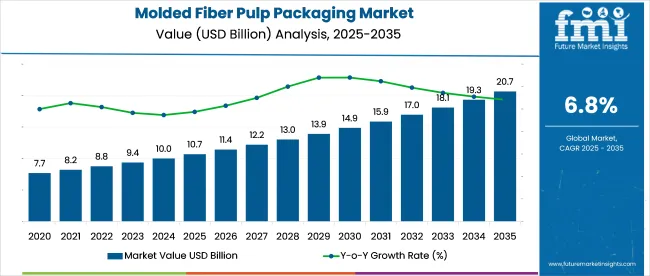

The molded fiber pulp packaging market demonstrates distinct growth phases with varying market characteristics and competitive dynamics. Between 2025 and 2030, the market progresses through its renewable material adoption phase, expanding from USD 4,238 million to USD 5,612 million with steady annual increments averaging 5.8% growth. This period showcases the transition from traditional foam packaging solutions to advanced fiber systems with enhanced cushioning capabilities and integrated protective design becoming mainstream features.
The 2025-2030 phase adds USD 1,374 million to market value, representing 35% of total decade expansion. Market maturation factors include standardization of molding protocols, declining component costs for recycled fiber sources, and increasing manufacturer awareness of pulp packaging benefits reaching 70-75% effectiveness in protective applications. Competitive landscape evolution during this period features established manufacturers like Huhtamaki Oyj and UFP Technologies expanding their molded pulp portfolios while new entrants focus on specialized cushioning solutions and enhanced structural design.
As per FMI’s comprehensive packaging sector study, reflecting shifts in barrier materials and eco-design strategies, from 2030 to 2035, market dynamics shift toward advanced customization and multi-product deployment, with growth accelerating from USD 5,612 million to USD 8,182.3 million, adding USD 2,542 million or 65% of total expansion. This phase transition logic centers on universal molded pulp systems, integration with automated forming equipment, and deployment across diverse application scenarios, becoming standard rather than specialized packaging formats. The competitive environment matures with focus shifting from basic protective quality to comprehensive production line integration and compatibility with high-speed molding systems.
At-a-Glance Metrics
| Metric | Value |
|---|---|
| Market Value (2025) | USD 4,238 million |
| Market Forecast (2035) | USD 8,182.3 million |
| Growth Rate | 6.8% CAGR |
| Leading Technology | Transfer Molded |
| Primary Application | Food & Beverage Segment |
The market demonstrates strong fundamentals with transfer molded systems capturing a dominant share through superior structural integrity and reliable protective capabilities. Food and beverage applications drive primary demand, supported by increasing plastic replacement requirements and protective packaging management solutions. Geographic expansion remains concentrated in developed markets with established food service infrastructure, while emerging economies show accelerating adoption rates driven by disposable income growth and rising environmental awareness.
Market expansion rests on three fundamental shifts driving adoption across food service and consumer goods sectors. 1. Plastic replacement demand creates compelling advantages through molded pulp systems that provide renewable material alternatives with comparable protective performance, enabling manufacturers to transition away from polystyrene formats while maintaining cushioning effectiveness and justifying competitive pricing versus traditional foam packaging. 2. Food service expansion accelerates as restaurant chains and quick service operators worldwide seek compostable container systems that deliver grease resistance directly to customers, enabling takeaway operations that align with municipal composting programs and waste diversion requirements. 3. E-commerce logistics drives adoption from electronics and consumer goods manufacturers requiring protective packaging solutions that maximize product safety during shipping while reducing dimensional weight and transportation costs.
However, growth faces headwinds from moisture sensitivity challenges that vary across application segments regarding liquid resistance and structural integrity, potentially limiting deployment flexibility in high-moisture food categories. Fiber sourcing complexity also persists regarding recycled content specifications and pulp quality standards that may increase raw material costs in markets with limited paper recovery infrastructure.
The molded fiber pulp packaging market represents a compelling intersection of protective packaging innovation, material circularity, and waste reduction management. With robust growth projected from USD 4,238 million in 2025 to USD 8,182.3 million by 2035 at a 6.8% CAGR, this market is driven by increasing plastic substitution trends, food service protective requirements, and consumer demand for compostable packaging formats.
The market's expansion reflects a fundamental shift in how food manufacturers and electronics companies approach protective packaging infrastructure. Strong growth opportunities exist across diverse applications, from food service operations requiring disposable containers to electronics facilities demanding cushioning protection. Geographic expansion is particularly pronounced in Asia-Pacific markets, led by China (8.1% CAGR) and India (7.8% CAGR), while established markets in North America and Europe drive innovation and specialized segment development.
The dominance of transfer molded systems and food and beverage applications underscores the importance of proven protective technology and structural design in driving adoption. Production complexity and fiber sourcing remain key challenges, creating opportunities for companies that can deliver reliable performance while maintaining operational efficiency.
Primary Classification: The market segments by molding type into transfer molded, thick wall, thermoformed, and processed pulp categories, representing the evolution from basic egg carton designs to advanced protective substrates for comprehensive cushioning packaging operations.
Secondary Breakdown: Application segmentation divides the market into food and beverage, consumer durables, electronics, healthcare, automotive, industrial, and others sectors, reflecting distinct requirements for protective performance, structural design, and compostability compliance.
Regional Classification: Geographic distribution covers North America, Europe, Asia Pacific, Latin America, and the Middle East & Africa, with developed markets leading innovation while emerging economies show accelerating growth patterns driven by food service expansion programs.
The segmentation structure reveals technology progression from standard egg carton molding toward integrated multi-cavity platforms with enhanced structural and barrier capabilities, while application diversity spans from food service operations to electronics facilities requiring precise cushioning and impact protection solutions.
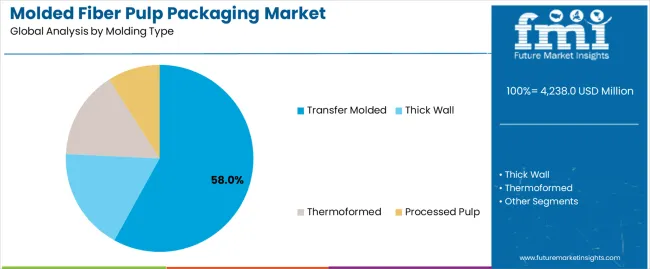
Transfer molded segment is estimated to account for 58% of the molded fiber pulp packaging market share in 2025. The segment's leading position stems from its fundamental role as a critical component in protective packaging applications and its extensive use across multiple food service and electronics sectors. Transfer molded's dominance is attributed to its superior structural integrity, including fine detail capability, smooth surface finish, and design flexibility that make it indispensable for complex packaging operations.
Market Position: Transfer molded systems command the leading position in the molded fiber pulp packaging market through advanced molding technologies, including comprehensive cavity options, surface quality excellence, and reliable dimensional consistency that enable manufacturers to deploy precise protective solutions across diverse application environments.
Value Drivers: The segment benefits from producer preference for proven forming methods that provide exceptional strength without requiring thick wall construction. Cost-effective manufacturing processes enable deployment in food containers, electronics cushioning, and consumer goods applications where structural performance and aesthetic quality represent critical production requirements.
Competitive Advantages: Transfer molded systems differentiate through excellent surface smoothness, proven dimensional accuracy, and compatibility with high-speed automated forming equipment that enhance product presentation while maintaining economical operational profiles suitable for diverse protective applications.
Key market characteristics:
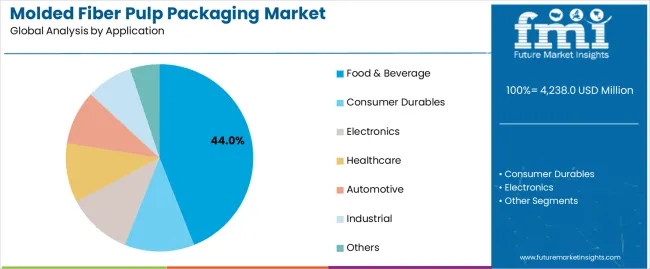
Food and beverage segment is projected to hold 44% of the molded fiber pulp packaging market share in 2025. The segment's market leadership is driven by the extensive use of molded pulp in egg cartons, fruit trays, beverage carriers, and takeaway containers, where packaging serves as both a protective structure and compostable disposal option. The food service industry's consistent investment in plastic alternative materials supports the segment's dominant position.
Market Context: Food and beverage applications dominate the market due to widespread adoption of disposable container materials and increasing focus on grease resistance management, liquid containment, and quick service restaurant applications that enhance operational efficiency while maintaining food safety standards.
Appeal Factors: Food manufacturers and restaurant chains prioritize structural integrity, moisture resistance, and integration with automated filling protocols that enable coordinated deployment across multiple service channels. The segment benefits from substantial regulatory momentum and waste diversion mandates that emphasize compostable packaging for food contact and beverage service applications.
Growth Drivers: Quick service restaurant expansion programs incorporate molded pulp as standard format for takeaway containers and beverage carriers. At the same time, food retail initiatives are increasing demand for protective trays that comply with food safety standards and enhance product presentation.
Market Challenges: Liquid resistance limitations and coating requirements may restrict deployment flexibility in high-moisture food categories or extended storage scenarios.
Application dynamics include:
Growth Accelerators: Plastic replacement drives primary adoption as molded pulp systems provide exceptional renewable alternatives that enable environmental compliance without sacrificing protective performance, supporting waste reduction and circular economy principles that require biodegradable disposal formats. Food service expansion accelerates market growth as quick service restaurants seek cost-effective packaging solutions that maintain food safety during delivery while enhancing brand positioning through visible environmental commitments. E-commerce growth increases worldwide, creating sustained demand for protective cushioning systems that complement fragile product shipping and provide competitive advantages in logistics cost reduction.
Growth Inhibitors: Moisture sensitivity challenges vary across application segments regarding liquid resistance and structural stability requirements, which may limit market penetration and performance margins in high-moisture categories with demanding barrier specifications. Fiber sourcing complexity persists regarding recycled content availability and pulp quality consistency that may increase supply chain risks in regions with developing paper recovery infrastructure. Market fragmentation across multiple molding technologies and design specifications creates compatibility concerns between different forming equipment and existing packaging operations.
Market Evolution Patterns: Adoption accelerates in food service and electronics sectors where protective performance justifies material transitions, with geographic concentration in developed markets transitioning toward mainstream adoption in emerging economies driven by disposable income growth and regulatory pressure expansion. Technology development focuses on enhanced barrier coatings, improved structural designs, and integration with automated forming systems that optimize production efficiency and packaging performance. The market could face disruption if advanced bio-plastic alternatives or material innovations significantly challenge molded pulp advantages in protective packaging applications.
The molded fiber pulp packaging market demonstrates varied regional dynamics with Growth Leaders including China (8.1% CAGR) and India (7.8% CAGR) driving expansion through food service growth and consumer goods development. Steady Performers encompass the USA (7.3% CAGR), Germany (6.5% CAGR), and Japan (6.1% CAGR), benefiting from established waste management sectors and specialty application adoption.
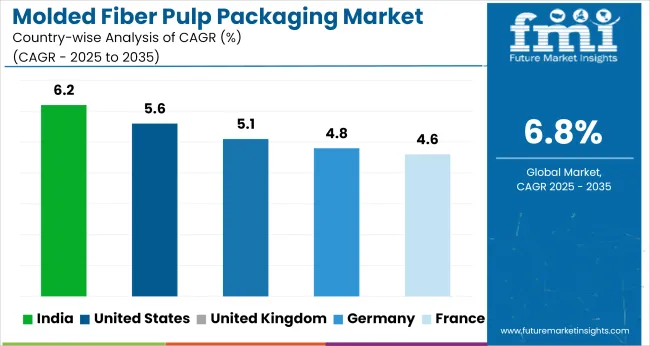
| Country | CAGR (2025 to 2035) |
|---|---|
| China | 8.1% |
| India | 7.8% |
| USA | 7.3% |
| Germany | 6.5% |
| Japan | 6.1% |
Regional synthesis reveals Asia-Pacific markets leading growth through food service expansion and consumer goods development, while European countries maintain steady expansion supported by specialized waste management programs and circular economy requirements. North American markets show strong growth driven by quick service restaurant applications and e-commerce protective packaging.
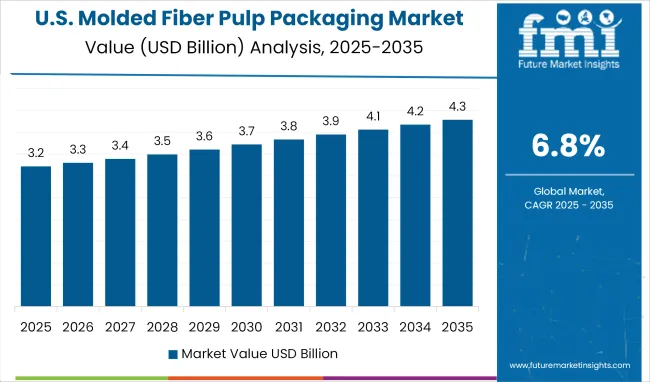
China establishes regional leadership through explosive quick service restaurant expansion and comprehensive consumer goods development, integrating advanced molded pulp systems as standard components in takeaway packaging and electronics cushioning applications. The country's 8.1% CAGR through 2035 reflects government initiatives promoting plastic reduction and domestic manufacturing capabilities that mandate the use of renewable packaging systems in food service operations. Growth concentrates in major urban centers, including Shanghai, Guangzhou, and Shenzhen, where food delivery platforms showcase integrated molded pulp containers that appeal to domestic consumers seeking convenient dining formats and environmental responsibility.
Chinese manufacturers are developing innovative molded pulp solutions that combine local production advantages with international quality specifications, including high-speed forming systems and advanced coating capabilities.
Strategic Market Indicators:
The Indian market emphasizes food service applications, including rapid restaurant growth development and comprehensive food safety infrastructure expansion that increasingly incorporates molded pulp for takeaway containers and beverage carriers. The country is projected to show a 7.8% CAGR through 2035, driven by massive quick service restaurant expansion under urbanization programs and commercial demand for affordable, hygienic packaging systems. Indian food manufacturers prioritize cost-effectiveness with molded pulp delivering protective performance through economical material usage and efficient production capabilities.
Technology deployment channels include major food service operators, regional packaging manufacturers, and agricultural packaging producers that support high-volume production for domestic and export applications.
Performance Metrics:
The USA market emphasizes advanced molded pulp features, including innovative coating technologies and integration with comprehensive waste management platforms that handle municipal composting, packaging recovery, and circular economy applications through unified material systems. The country is projected to show a 7.3% CAGR through 2035, driven by quick service restaurant expansion under plastic reduction programs and commercial demand for convenient, compostable packaging systems. American food service companies prioritize operational efficiency with molded pulp delivering cost savings through lightweight construction and waste diversion benefits.
Technology deployment channels include major restaurant chains, food packaging distributors, and electronics manufacturers that support custom development for protective packaging operations.
Performance Metrics:
In Berlin, Munich, and Hamburg, German food manufacturers and consumer goods companies are implementing advanced molded pulp packaging systems to enhance waste diversion capabilities and support circular economy principles that align with environmental regulations and quality standards. The German market demonstrates sustained growth with a 6.5% CAGR through 2035, driven by waste management innovation programs and specialized packaging investments that emphasize renewable material systems for food service and consumer goods applications. German packaging facilities are prioritizing molded pulp systems that provide exceptional structural performance while maintaining compliance with composting standards and minimizing waste generation, particularly important in retail food service and premium consumer goods operations.
Market expansion benefits from extended producer responsibility programs that mandate compostable packaging in food service specifications, creating sustained demand across Germany's hospitality and retail sectors, where material circularity and disposal compliance represent critical requirements.
Strategic Market Indicators:
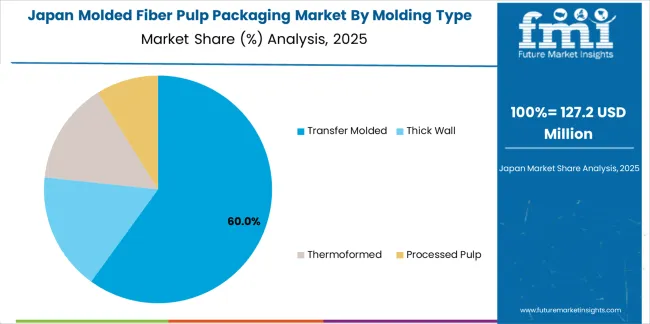
Japan's sophisticated food service market demonstrates meticulous molded pulp deployment, growing at 6.1% CAGR, with documented operational excellence in protective packaging and food container applications through integration with existing waste management systems and quality assurance infrastructure. The country leverages engineering expertise in precision manufacturing and material science to maintain market leadership. Packaging centers, including Tokyo, Osaka, and Nagoya, showcase advanced installations where molded pulp systems integrate with comprehensive production platforms and inventory management systems to optimize packaging efficiency and waste reduction.
Japanese food manufacturers prioritize packaging precision and structural reliability in material development, creating demand for flawless molded pulp systems with advanced features, including moisture resistance and integration with automated filling protocols. The market benefits from established food safety infrastructure and willingness to invest in specialized packaging technologies that provide superior product protection and regulatory compliance.
Market Intelligence Brief:

The molded fiber pulp packaging market in Europe is projected to grow from USD 1,312 million in 2025 to USD 2,289 million by 2035, registering a CAGR of 5.7% over the forecast period. Germany is expected to maintain its leadership position with a 41.3% market share in 2025, declining slightly to 40.8% by 2035, supported by its waste management excellence and major production centers, including Baden-Württemberg and Bavaria.
France follows with a 21.7% share in 2025, projected to reach 22.1% by 2035, driven by comprehensive food service packaging and retail container initiatives. The United Kingdom holds a 15.4% share in 2025, expected to maintain 15.7% by 2035 through established food delivery sectors and e-commerce packaging adoption. Italy commands a 10.8% share, while Spain accounts for 8.3% in 2025. The Rest of Europe region is anticipated to gain momentum, expanding its collective share from 2.5% to 2.8% by 2035, attributed to increasing plastic reduction policies in Eastern European countries and emerging Nordic food service facilities implementing compostable packaging programs.
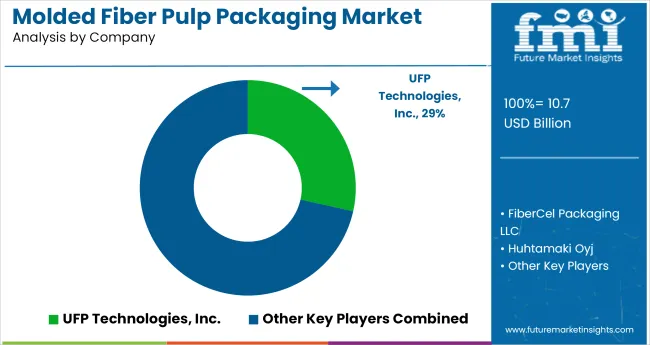
The molded fiber pulp packaging market operates with moderate concentration, featuring approximately 18-25 participants, where leading companies control roughly 42-48% of the global market share through established food service relationships and comprehensive molding equipment capabilities. Competition emphasizes structural design, moisture resistance, and production efficiency rather than price-based rivalry.
Market leaders encompass Huhtamaki Oyj, UFP Technologies, and Pactiv Evergreen, which maintain competitive advantages through extensive material expertise, global production networks, and comprehensive forming line integration capabilities that create customer loyalty and support technical specifications. These companies leverage decades of fiber molding experience and ongoing coating technology investments to develop advanced molded pulp systems with exceptional protective and performance features.
Specialty challengers include Enviro PAK Corporation, Brodrene Hartmann A/S, and Henry Molded Products, which compete through specialized food service packaging focus and innovative structural solutions that appeal to restaurant chains seeking cost-effective container formats and high-speed production flexibility. These companies differentiate through design engineering emphasis and specialized food contact application focus.
Market dynamics favor participants that combine reliable protective performance with advanced production support, including equipment integration and material certification capabilities. Competitive pressure intensifies as traditional paperboard manufacturers expand into molded pulp systems. At the same time, specialized packaging companies challenge established players through innovative coating solutions and cost-effective production targeting emerging food service segments.
| Item | Value |
|---|---|
| Quantitative Units | USD 4,238 million |
| Molding Type | Transfer Molded, Thick Wall, Thermoformed, Processed Pulp |
| Application | Food & Beverage, Consumer Durables, Electronics, Healthcare, Automotive, Industrial, Others |
| Regions Covered | North America, Europe, Asia Pacific, Latin America, Middle East & Africa |
| Countries Covered | USA, Germany, Japan, China, India, and 25+ additional countries |
| Key Companies Profiled | Huhtamaki Oyj, UFP Technologies, Pactiv Evergreen, EnviroPAK Corporation, Brodrene Hartmann A/S, Henry Molded Products |
| Additional Attributes | Dollar sales by molding type and application categories, regional adoption trends across North America, Europe, and Asia-Pacific, competitive landscape with fiber packaging manufacturers and food service suppliers, producer preferences for structural excellence and forming efficiency, integration with high-speed production equipment and automated systems, innovations in coating technology and structural design, and development of specialized barrier solutions with enhanced protection and compostability capabilities |
The global molded fiber pulp packaging market is estimated to be valued at USD 4,238.0 million in 2025.
The market size for the molded fiber pulp packaging market is projected to reach USD 8,182.3 million by 2035.
The molded fiber pulp packaging market is expected to grow at a 6.8% CAGR between 2025 and 2035.
The key product types in molded fiber pulp packaging market are transfer molded, thick wall, thermoformed and processed pulp.
In terms of application, food & beverage segment to command 44.0% share in the molded fiber pulp packaging market in 2025.






Full Research Suite comprises of:
Market outlook & trends analysis
Interviews & case studies
Strategic recommendations
Vendor profiles & capabilities analysis
5-year forecasts
8 regions and 60+ country-level data splits
Market segment data splits
12 months of continuous data updates
DELIVERED AS:
PDF EXCEL ONLINE
Molded Fiber Pulp Packaging Industry Analysis in Australia and New Zealand Forecast Outlook 2025 to 2035
Molded Fiber Pulp Packaging Market Size and Share Forecast Outlook 2025 to 2035
Molded Fiber Pulp Packaging industry Analysis in USA and Canada - Size, Share, and Forecast Outlook 2025 to 2035
Market Share Breakdown of Molded Fiber Pulp Packaging Providers
Europe Molded Fiber Pulp Packaging Market Analysis – Demand, Growth & Future Outlook 2024-2034
Japan Molded Fiber Pulp Packaging Market Trends – Growth & Forecast 2023-2033
Korea Molded Fiber Pulp Packaging Market Insights – Trends & Forecast 2023-2033
Western Europe Molded Fiber Pulp Packaging Market Insights – Growth & Forecast 2023-2033
Breaking Down Market Share in Europe Molded Fiber Pulp Packaging
Market Share Breakdown of USA and Canada Molded Fiber Pulp Packaging Manufacturers
Molded Wood Pallets Market Forecast and Outlook 2025 to 2035
Molded FRP Grating Market Size and Share Forecast Outlook 2025 to 2035
Molded Foam Market Size and Share Forecast Outlook 2025 to 2035
Molded Underfill Material Market Size and Share Forecast Outlook 2025 to 2035
Competitive Overview of Molded Wood Pallets Market Share
Molded Case Circuit Breaker (MCCB) Market Growth – Trends & Forecast 2023-2033
Molded Interconnect Devices (MID) Market
Molded Pulp Basket Market Size and Share Forecast Outlook 2025 to 2035
Market Share Breakdown of the Molded Pulp Basket Industry
Molded Pulp Packaging Market Size and Share Forecast Outlook 2025 to 2035

Thank you!
You will receive an email from our Business Development Manager. Please be sure to check your SPAM/JUNK folder too.
Chat With
MaRIA